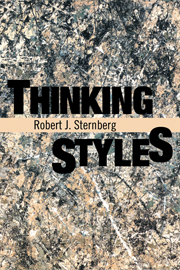Book contents
- Frontmatter
- Contents
- Preface
- Part I The Nature of Thinking Styles
- 1 What Are Thinking Styles and Why Do We Need Them?
- 2 Functions of Thinking Styles: The Legislative, Executive, and Judicial Styles
- 3 Forms of Thinking Styles: The Monarchic, Hierarchic, Oligarchic, and Anarchic Styles
- 4 Levels, Scope, and Leanings of Thinking Styles: The Global, Local, Internal, External, Liberal, and Conservative Styles
- Part II The Principles and Development of Thinking Styles
- Part III Thinking Styles in School and in Research and Theory
- Notes
- Index
2 - Functions of Thinking Styles: The Legislative, Executive, and Judicial Styles
Published online by Cambridge University Press: 05 August 2012
- Frontmatter
- Contents
- Preface
- Part I The Nature of Thinking Styles
- 1 What Are Thinking Styles and Why Do We Need Them?
- 2 Functions of Thinking Styles: The Legislative, Executive, and Judicial Styles
- 3 Forms of Thinking Styles: The Monarchic, Hierarchic, Oligarchic, and Anarchic Styles
- 4 Levels, Scope, and Leanings of Thinking Styles: The Global, Local, Internal, External, Liberal, and Conservative Styles
- Part II The Principles and Development of Thinking Styles
- Part III Thinking Styles in School and in Research and Theory
- Notes
- Index
Summary
Governments can be organized in many different ways, but all of them need to accomplish at least three different functions: They need to legislate; they need to execute the legislation they pass; and they need to judge whether the legislation is consistent with their principles, and if it is, whether people are acting in accord with the legislation.
Before presenting each style, I will first give you an opportunity to assess yourself on the style. Take the self-assessment before reading about the style. It will help you understand the style better, as well as to understand yourself better.
Because the instructions are the same for all the self-assessments in the book, the full instructions are given in advance here, and then just summarized for each individual self-assessment. Each of the self-assessments in this chapter and in Chapters 2 to 4 is from the Sternberg-Wagner Thinking Styles Inventory.
Instructions for Stylistic Self-Assessment
Read each statement carefully and decide how well it describes you. Use the scale provided to indicate how well the statement fits the way you typically do things on the job, at home, or at school. Write 1 if the statement does not fit you at all, that is, you almost never do things this way. Write 7 if the statement fits you extremely well, that is, you almost always do things this way.
- Type
- Chapter
- Information
- Thinking Styles , pp. 27 - 43Publisher: Cambridge University PressPrint publication year: 1997
- 1
- Cited by



